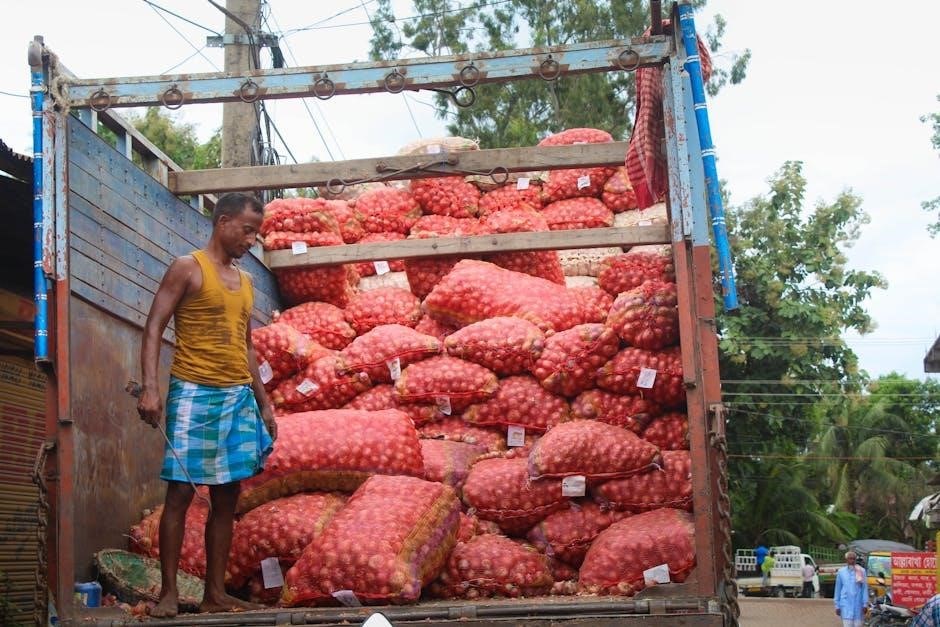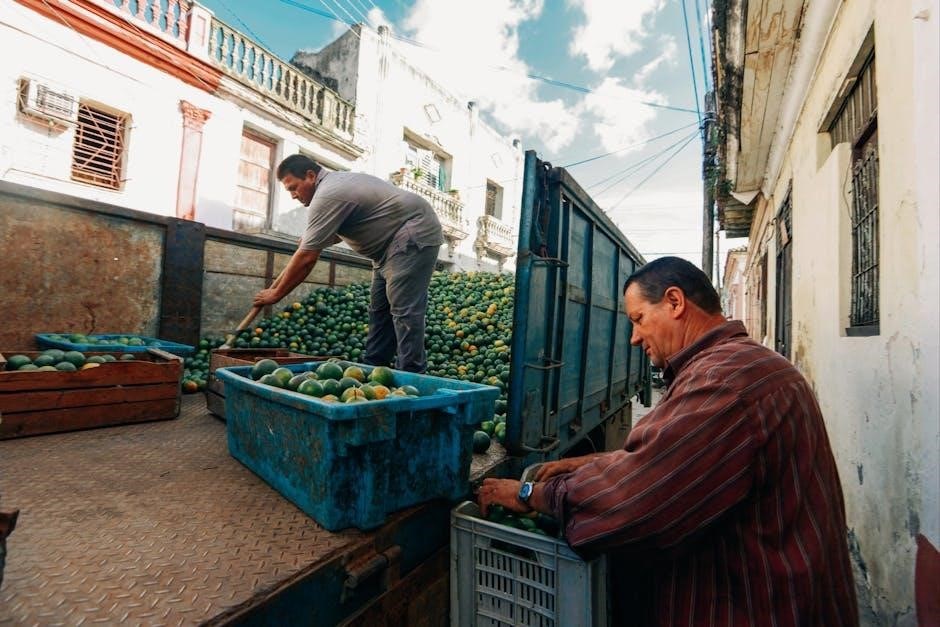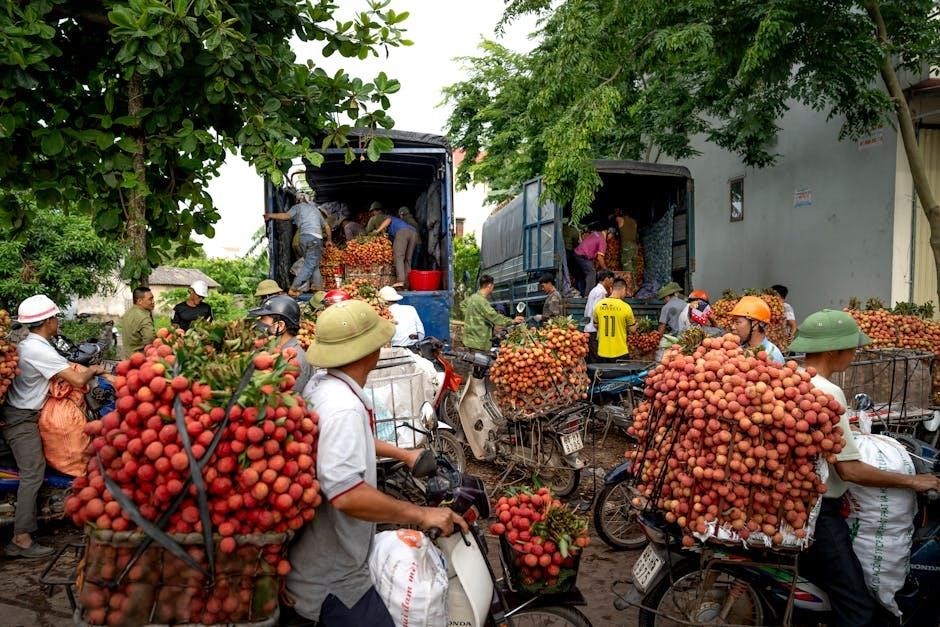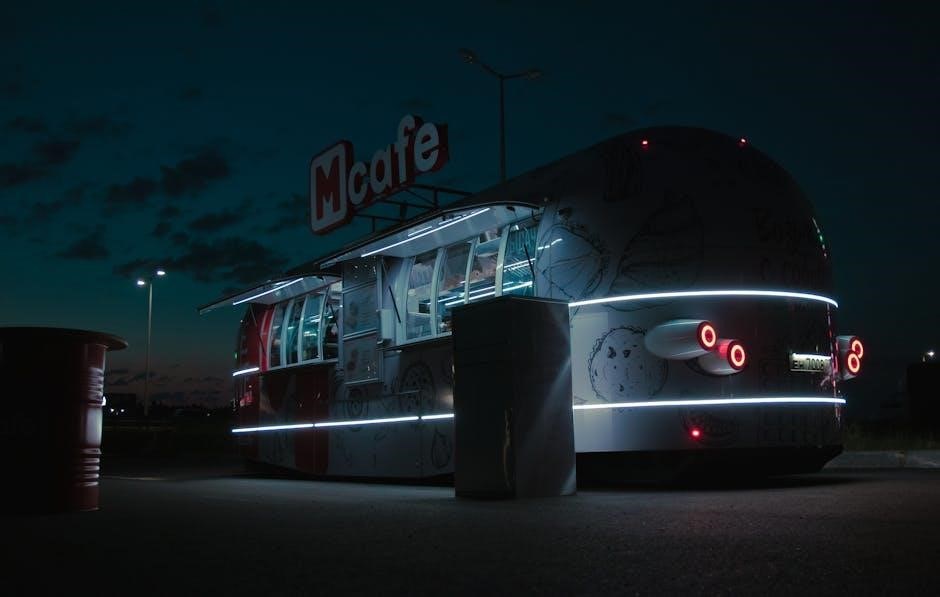Executive Summary
The food truck business plan outlines a strategic approach to capitalize on the growing demand for mobile cuisine, targeting busy consumers with diverse, high-quality offerings.
1.1 Overview of the Food Truck Business
The food truck business is a rapidly growing segment of the foodservice industry, offering mobility and flexibility. It caters to diverse customer preferences with innovative menus, from prepared dishes to pre-packaged items. This model attracts entrepreneurs due to lower startup costs compared to traditional restaurants, making it an accessible venture with high potential for scalability and profitability in urban and event-based markets.
1.2 Mission and Vision Statements
The mission is to deliver exceptional, affordable dining experiences through a diverse menu, emphasizing quality and customer satisfaction. The vision is to become a leading food truck brand, recognized for innovation, sustainability, and community engagement, while fostering long-term growth and profitability in the competitive mobile food industry.
1.3 Objectives and Goals
Key objectives include launching the food truck within six months, achieving a revenue target of $250,000 in the first year, and securing prime locations in high-traffic areas. Goals also focus on building a loyal customer base, maintaining a 90% customer satisfaction rate, and expanding the menu seasonally to ensure freshness and variety while establishing a strong online presence through social media and a dedicated website.

Company Description
Our food truck business, “Tasty Wheels,” offers diverse, high-quality street food, catering to urban professionals and event-goers. We prioritize sustainability and locally sourced ingredients.
2.1 Business Structure and Ownership
Our food truck business operates as a sole proprietorship, owned by [Your Name], offering flexibility in decision-making. This structure simplifies legal and tax requirements, allowing focus on growth and innovation.
2.2 Products and Services Offered
Our menu features a diverse range of high-quality, freshly prepared meals, including gourmet burgers, specialty tacos, and healthy salads. We also offer customizable options to cater to dietary preferences and allergies, ensuring inclusivity for all customers. Beverages include organic coffee, fresh juices, and craft sodas, providing a complete dining experience on the go.
2.3 Unique Selling Points (USP)
Our food truck stands out with its commitment to sustainability, using eco-friendly packaging and locally sourced ingredients. We offer a fusion of global cuisines with innovative twists, creating a unique tasting experience. Additionally, our real-time location updates and online ordering system enhance customer convenience, setting us apart from competitors in the mobile food industry.

Market Analysis
The food truck market is rapidly growing, driven by increasing demand for convenient dining. It offers a profitable alternative to traditional restaurants with lower startup costs.
3.1 Industry Overview and Growth Potential
The food truck industry is experiencing rapid growth, fueled by busy lifestyles and diverse culinary preferences. With startup costs as low as $50,000, it offers a profitable alternative to traditional restaurants. The market is projected to outpace the broader food service industry, making it an attractive venture for entrepreneurs seeking flexibility and scalability in the culinary sector.
3.2 Target Market and Customer Segmentation
The target market includes office workers, students, and event attendees seeking convenient, affordable meals. Key segments are young professionals aged 18-35, families, and festival-goers. Location strategy focuses on high-traffic areas like downtown districts, universities, and event venues. Menu customization caters to diverse preferences, ensuring broad appeal and repeat business, while leveraging social media engagement to attract tech-savvy customers.
3.3 Competitive Analysis
The food truck industry is highly competitive, with numerous operators offering diverse cuisines. Key competitors include established trucks, street vendors, and restaurants with mobile units. Differentiation lies in unique menu offerings, superior quality, and exceptional customer service. Market research highlights the need for a strong brand identity and strategic location selection to stand out. Understanding competitors’ strengths and weaknesses is crucial for positioning and pricing strategies.

Menu and Pricing Strategy
The menu offers a variety of cuisines, emphasizing quality and affordability. Pricing strategies balance profitability and customer appeal, ensuring revenue growth and satisfaction;
4.1 Menu Development and Concept
The menu will feature diverse, high-quality dishes catering to various tastes and dietary preferences. Inspired by current food trends, offerings will include signature items, healthy options, and seasonal specials. The concept emphasizes fresh, locally-sourced ingredients to ensure flavor and sustainability. Menu items will be priced competitively, with portion sizes designed for on-the-go consumption. Regular updates and limited-time offers will keep the menu engaging and innovative.
4.2 Pricing Strategy and Revenue Model
The pricing strategy will balance affordability with profitability, targeting $8-$12 per item. Menu items will be competitively priced to attract a wide customer base while ensuring high margins. Revenue streams include daily sales, event bookings, and catering services. Payment methods will accept cash, cards, and mobile payments for convenience. Seasonal promotions and loyalty programs will boost repeat business and customer retention, enhancing overall revenue potential.

Marketing and Sales Strategy
The marketing strategy focuses on building a strong brand identity, leveraging social media engagement, and utilizing location-based marketing to drive customer loyalty and sales growth;
5.1 Branding and Marketing Plan
The branding strategy emphasizes creating a unique and memorable identity through a catchy logo, vibrant visuals, and a tagline reflecting the truck’s culinary style. Social media platforms like Instagram and Facebook will be utilized to share high-quality images, behind-the-scenes content, and customer testimonials, fostering engagement and loyalty. Influencer collaborations and limited-time promotions will further enhance brand visibility and attract a broader audience.
5.2 Sales Channels and Customer Acquisition
Primary sales channels include high-traffic locations like festivals, city centers, and event venues. Partnerships with local businesses and universities will expand reach. Online presence through a website and social media will support orders and location tracking. Promotions, such as discounts for first-time customers and loyalty programs, will drive retention and attract new patrons, ensuring consistent foot traffic and revenue growth for the food truck business.

Operations Plan
The food truck business requires efficient location scouting, logistics management, and adherence to health regulations. Key operational aspects include equipment maintenance, supply procurement, and staff training to ensure smooth daily operations.
6.1 Location and Logistics
Identifying high-traffic locations such as festivals, events, and busy streets is crucial for maximizing visibility and sales. Ensure compliance with local permits and zoning regulations. Logistics involve scheduling routes, managing inventory, and maintaining equipment. Efficient supply chain management and waste disposal systems are essential for smooth operations. Regularly monitor location performance to optimize profitability and customer satisfaction.
6.2 Equipment and Supplies
The food truck requires essential equipment such as grills, fryers, refrigerators, and cooking utensils to prepare and store food safely. Quality supplies, including ingredients, packaging materials, and disposable items, are vital for daily operations. Regular maintenance of equipment ensures functionality and longevity. Compliance with health and safety regulations is non-negotiable to avoid operational disruptions and legal issues.
6.3 Staffing and Training
Hiring qualified staff, including chefs, cashiers, and managers, is crucial for smooth operations. Comprehensive training programs will ensure staff mastery of food preparation, safety protocols, and customer service. Scheduling will be optimized to meet peak demand periods. Ongoing training will foster a skilled and motivated team, enhancing customer satisfaction and business growth.

Financial Plan

The financial plan outlines startup costs, funding requirements, and revenue projections. It details expenses, profit margins, and strategies to ensure long-term profitability and financial stability.
7.1 Startup Costs and Funding Requirements
Startup costs for a food truck business typically range from $50,000 to $200,000, covering the truck, equipment, permits, and initial marketing. Funding requirements include securing loans, investors, or personal savings. A detailed breakdown of expenses ensures transparency and helps in seeking financial support effectively.
7.2 Revenue Projections and Profitability
Revenue projections for a food truck vary based on location and menu. Average daily revenue ranges from $300 to $500, leading to annual projections of $150,000. Factors like high-traffic areas and unique offerings significantly impact profitability. With efficient operations, net profit margins can reach 10-15% annually, making food trucks a viable business with strong growth potential.

Sustainability and Risk Management
Sustainability practices include eco-friendly packaging and locally sourced ingredients. Risk management involves strategies to address location challenges, market fluctuations, and operational disruptions.
8.1 Sustainability Practices
The food truck business prioritizes sustainability by using eco-friendly packaging, sourcing ingredients locally, and reducing food waste. Energy-efficient equipment and green certifications are also key initiatives to minimize environmental impact.
8.2 Risk Assessment and Mitigation Strategies
The food truck business faces risks like fluctuating demand, regulatory challenges, and equipment failures. Mitigation includes diversifying the menu, securing multiple locations, and maintaining contingency funds. Regular inspections and staff training ensure compliance and operational efficiency, while insurance coverage protects against unforeseen events. A detailed emergency plan is also in place to address potential crises effectively.
The food truck business plan provides a clear roadmap for success, emphasizing market potential, strategic planning, and adaptability. Starting your venture today can yield long-term growth.
9.1 Summary of Key Points
The food truck business plan highlights market growth, targeting busy consumers with diverse, high-quality offerings. It emphasizes unique selling points, competitive strategies, and financial planning to ensure profitability. By focusing on key elements like location, menu development, and branding, the plan provides a roadmap for success in the mobile food industry.
- Focuses on market growth and consumer trends.
- Emphasizes unique offerings and competitive strategies.
- Provides a clear roadmap for financial success.
- Highlights importance of location and branding.
9.2 Final Thoughts and Next Steps
- Secure necessary funding and permits.
- Finalize menu and source high-quality ingredients.
- Develop a strong brand identity and marketing strategy.
- Launch operations in high-traffic locations.

Appendix
The appendix provides additional resources, including sample business plans, templates, and market research, offering comprehensive support for launching a successful food truck venture.
10.1 Supporting Documents and References
The appendix includes essential documents such as market research reports, sample business plans, and legal templates. These resources provide detailed insights and practical tools to support the food truck business plan. References include industry studies, financial templates, and operational guides. Additionally, links to downloadable PDFs and online resources are provided for further exploration and customization of the business strategy. These materials ensure a comprehensive foundation for launching and managing a successful food truck venture.
10.2 Additional Resources and Templates
Additional resources include downloadable templates for financial projections, marketing strategies, and operational checklists. Tools like AI-based business plan generators, such as PlanPros.ai, offer customizable solutions. Guides on sustainability practices and location scouting are also provided. These resources aim to equip entrepreneurs with practical tools to refine their business strategy and ensure a smooth launch of their food truck venture.



